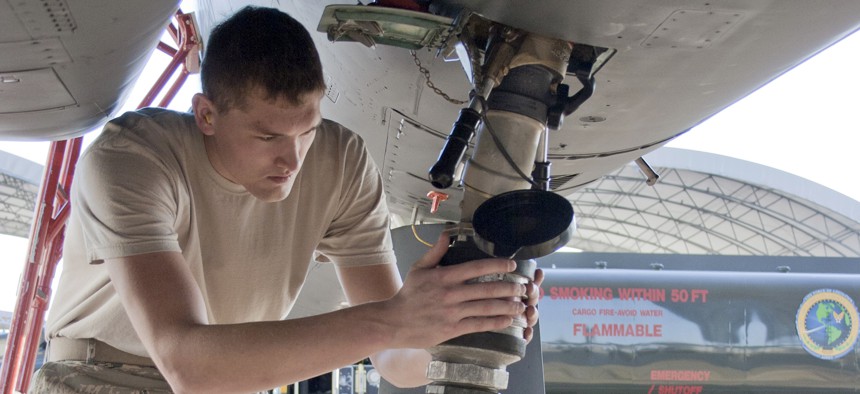
Senior Airman Jacob Prine checks the fuel connection to a F-15 Eagle in 2010. 2nd Lt. Andrew Caulk/U.S. Air Force
A Short-Staffed US Air Force Wants Robots to Do More Human Jobs
The service’s top general says new systems, from bombs to buildings, must be able to think, share, and learn.
KIRTLAND AIR FORCE BASE, N.M. — Filling the fuel tank of a B-2 stealth bomber is a group effort; the task involves pilots, maintainers, logisticians — not to mention fuel specialists. Gen. David Goldfein wants to know: can the Air Force give some of that work to machines, as airlines do?
“How do we take best practices from industry and automate parts of our flight line that right now are fairly manpower-intensive?” the Air Force chief of staff said in a recent interview. “If I have airmen doing things that can be automated, then I think we got to pursue it.”
Goldfein's quest for what he calls “smart flight lines” reflects both his desire to accomplish everyday tasks more efficiently and a stark realization that his service simply does not have enough people to do all its jobs.
During a six-day trip to four Air Force bases last month, Goldfein often sounded more like a wandering digital-age philosopher than a fighter pilot. He asked questions of about everyone he encountered — from teenage airmen who fix planes to wing commanders building new nuclear weapons — about how they are fitting robotics and automation technology into their plans.
“We’re too small for what the nation requires,” he said. “So there’s a part of this which means we have to grow, but we also have to be good stewards as well and look at the highest priority missions and look at how we’re using airmen today and find ways to repurpose airmen against the highest priorities.”
Goldfein is searching for new types of technology that could help prepare planes for battle.
“Our bases are part of our weapon system because we launch from land,” he said, alluding to a mission in January when two B-2s took off from Whiteman Air Force Base in Missouri and flew a 34-hour round trip to drop bombs on Islamic State camps in Libya.
“How of that can be automated? How much of that can we start to really look into some creative robotic technology use?” Goldfein said. “I do think there are some investments we have to make in that regard.”
Air Force leaders have spent recent years lamenting that they have been short-staffed — a shortage in pilots and maintenance crews that fix planes being among the most taxed career fields. Goldfein notes that his service is eventually slated to grow, but he wants a cultural shift in thinking that seeks technology to do what jobs it can, freeing up airmen to fill roles that machines cannot.
Of particular interest, he said, is how the Air Force will store and transport its new nuclear weapons more safely and efficiently.
During a stop at Barksdale Air Force Base, home of the 2d Bomb Wing, Goldfein asked how robotics and automation were being incorporated into a new building that will hold new nuclear cruise missiles. The airmen replied that since the new missile is still in the early stages of development, they were designing the new building as if it would hold the current cruise missile carried by the B-52.
Here at Kirtland Air Force Base, Goldfein posed the question to a colonel who works with munition storage at the Air Force’s Nuclear Weapons Center. The colonel explained that tight schedule demands has led to a hesitance to pursue new types technology.
Goldfein countered that he wants to make sure that new facilities are not run like the current ones.
Since becoming the Air Force’s top general, Goldfein has pushed for airmen to think differently about the future of war. He has been on a personal crusade to make sure all of the Air Force’s planes, satellites, and other weapons can all talk to one another digitally. That would be a shift: much of the U.S. arsenal was built by defense firms that used proprietary standards, preventing the weapons from communicating electronically and requiring lots of time and money to modify them.
So when a company pitches new weapons, Goldfein asks three questions: Does it share? Does it connect? Does it learn?
He said his push for more open systems — ones that the Air Force can modify itself — is beginning to be heeded by defense firms. At the Air Force Association’s annual trade show in September, Goldfein “was impressed and intrigued with how many of our industry partners started their conversation with me [with]: ‘let me tell you how this connects. Let me tell you how this shares.’”
“[T]his is a big challenge for us to be able to change fundamentally the way we think from wars of attrition — sensor, weapons, platforms — to wars of cognition, which is networks that share and learn,” he said. “Making that cultural shift and translating that to an acquisition strategy is going to be a big lift. But the faster we do it, the faster we’ll improve our lethality as a joint team.”
